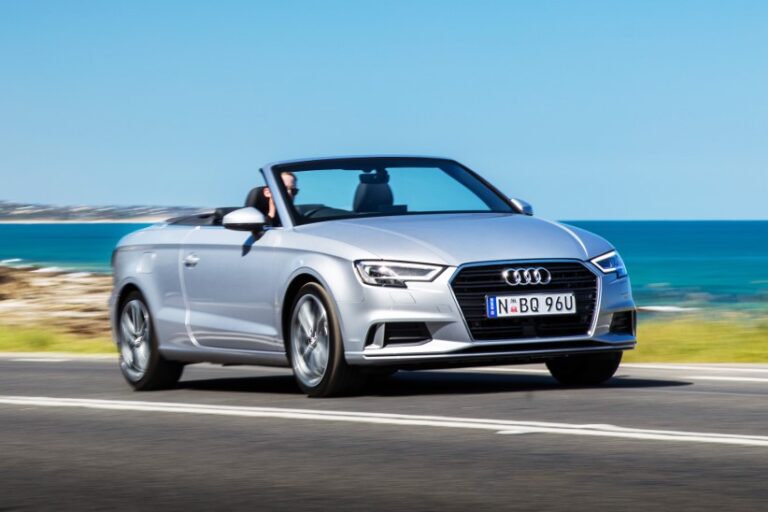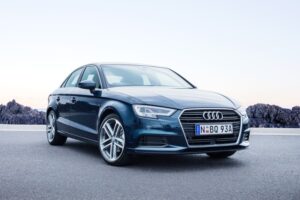– By David Brown –
Late in 2016 Audi launched the new A3 and S3 models into the Australian market.
Their penetration into the fleet market is small yet they have included a diesel engine A3 specifically targeted at the very fuel conscious buyer. But there are other reasons to buy this new model and all the new A3 and S3s will be a very popular novated vehicle.
The Audi A3 has been selling in Australia since 1996.
Its sales grew steadily but not spectacularly until the third generation was launched here midway through 2012.
In 2012 they sold approximately 1,413 cars, in 2015 they sold 6,275.
Obviously the performance and features of the cars has been improving but also the premium segment of the market has increased and is now 12% of our total car sales.
The new A3 comes with three body styles: the Sportback; the Sedan; and the Cabriolet.
There are also three petrol engines but the smallest engine is only available in the Sportback. But all models get the new seven speed S-Tronic dual clutch transmission. All body styles come with an all-wheel drive option but only with the largest engine.
The smallest engine is a 1.0 litre three cylinder turbo that is clearly aimed at achieving a low fuel consumption and thus reducing operating costs. It has 85kW and delivers 200 Nm of torque and is rated at a combined fuel consumption figure of 4.8 l/100.
While these are modest power figures, the car will do most things that you could want, certainly around the city. If you rev it out then it sounds like it is working hard but that is not what it was built for. It can still happily travel down the motorway at the speed limit without feeling like it is struggling. It is only available in the Sportback body style.
The next size engine is a 1.4 litre, petrol, four cylinder turbo with 110 KW and 250 Nm of torque. It offers more confident performance. It is available in all body styles and, surprisingly, is rated at not much more that the tiny motor at 5.0 l/100 for the Sportback.
One of the advantages of the 1.4 litre engine is that it has a “Cylinder on Demand” function which reduces the number of cylinders producing power if the load on the engine is low. At loads up to 100 Nm, and when coasting, the system deactivates the second and third cylinders, provided that the engine speed lies between 1,400 and 4,000 rpm.
The largest engine is the two litre, four cylinder turbo with 140 Kw and 320 Nm which makes it more effortless in its performance and is rated at 5.9 l/100 fuel consumption. You can add another 0.3 l/100 if you take the four-wheel drive option.
Audi have also released the performance S3 model which comes only with the 2 litre engine boosted to 213kw and 380 Nm and it is only available with the quattro four-wheel-drive system. It is available in all three body styles. This is a beautifully balanced machine that is solely for the performance oriented driver. Its fuel consumption is rated at 6.4 l/100 which is only of academic interest. If you want this sort of performance you are not focusing on fuel economy.
The comparable fuel consumption figures need to be taken with an element of caution. Work done in 2014 by the UK organisation, Emission Analytics, suggests that the difference between rated and real-life fuel consumption is usually higher in smaller engine cars (1 litre and below). But technology might have improved since then.
In this regard the “fleet special” A3 might be more desirable although we have not been able to test it at this time. The engine is a 1.6 litre turbo diesel with 81 Kw and 250 Nm. It is rated at 4.1 l/100. We will test this car in the future.
Audi continues to provide extensive technology to assist in the safety of their vehicles. In the new A3 you can have “Audi pre sense front” with predictive pedestrian protection and cross traffic assist at the rear. They have also improved systems such as Parking system plus, Audi active lane assist, Audi side assist, adaptive cruise control, park assist system (forward perpendicular parking is now possible).
In the cabin, Audi have made the controls, especially for navigation, easier to operate through their MMI system which works a bit like a computer mouse except with a nob. You can even trace letters and numbers on the top of the nob for entry into the navigation system.
The recommend retail prices (to which you have to add on road costs) for the Sportback models are:
- 1.0 TFSI – $35,900
- 1.4 TFSI CoD – $39,900
- 2.0 TFSI Sport – $45,900
- 2.0 TFSI quattro S line – $49,500
- S3 2.0 TFSI Quattro – $62,900
Add $1,600 for the sedan and further $7,500 for the cabriolet remembering that the sedan and the cabriolet are not available with the 1 litre engine.
Audi have not listed the price for the “fleet” diesel but they suggest it will be around $38,500 plus on road costs.
Some of the features mentioned here are not provided in all models.
If you are considering buying an Audi it is best to watch the cost of optional extras very closely. They can increase the price of the car significantly.








